Horse News
Member
Barefoot Benefits for Horses
For the past 20 years, I’ve exclusively worked with, ridden, and owned barefoot horses. I’ve been around barefoot horses so long that it comes as a bit of a surprise when I see a horse wearing shoes! Although there are many advantages to going barefoot, it’s not viable for all horses. In this article, we’re going to find out why.
You can’t simply whip off a horse’s shoes and hope for the best—going barefoot is a transition that takes time and patience if it’s to be a success.
For a horse to be comfortable barefoot, he needs thick soles and strong, healthy walls. He also needs to be on a diet that promotes strong hoof growth, and an exercise regime that encourages the development of tough, calloused hooves.
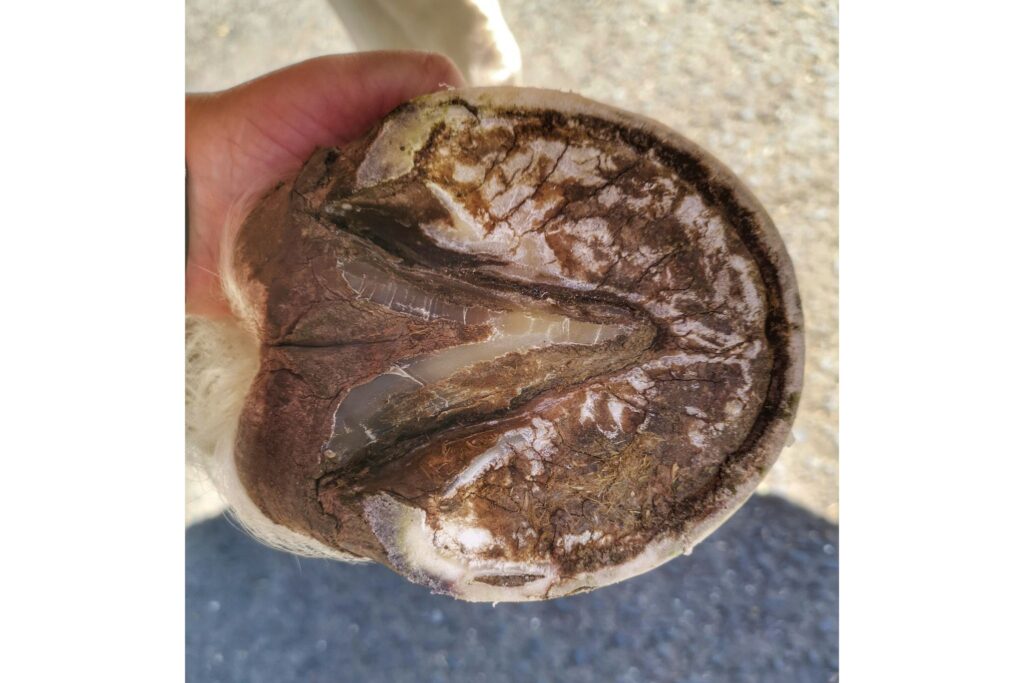
Source: Canva
Horse Hooves 101
You’ve probably heard the phrase, “No hoof, no horse” and it stands to reason that a horse needs four strong, healthy hooves as its foundation. Each hoof acts as a support mechanism for the limb above it, bearing weight, absorbing shock, and facilitating blood flow.
Shoes enable us to correct various hoof issues and conformation faults, strengthening the horse where he needs it most. That’s why not all horses can live comfortably without shoes.
Hoof Structure
A horse’s hoof is a complex biomechanical structure consisting of the following parts:
Hoof Wall – the hard weight-bearing section of the hoof that protects the internal structures and provides traction.
Sole – thinner than the wall, the sole is a layer of tough horn, a bit like your fingernails, that protects the sensitive parts of the hoof.
Frog – situated in the center of the hoof, the frog is a wedge-shaped cushion that facilitates shock absorption, traction, and blood circulation.
Heel – a digital cushion that aids shock absorption and protects the navicular bone and deep digital flexor tendon.
Toe – the front tip of the hoof wall.
Bar – the bars extend from the heel of the hoof along the sides of the frog, providing structure and support.
Heel Bulb – the heel bulbs at the back of the horse’s hoof act as shock absorbers.
White Line – this is the tissue that connects the sole of the hoof to the wall.
Coffin Bone – this is the main bone inside the horse’s hoof. It is encased inside the hoof wall, as though in a coffin, and forms the foundation of the hoof.
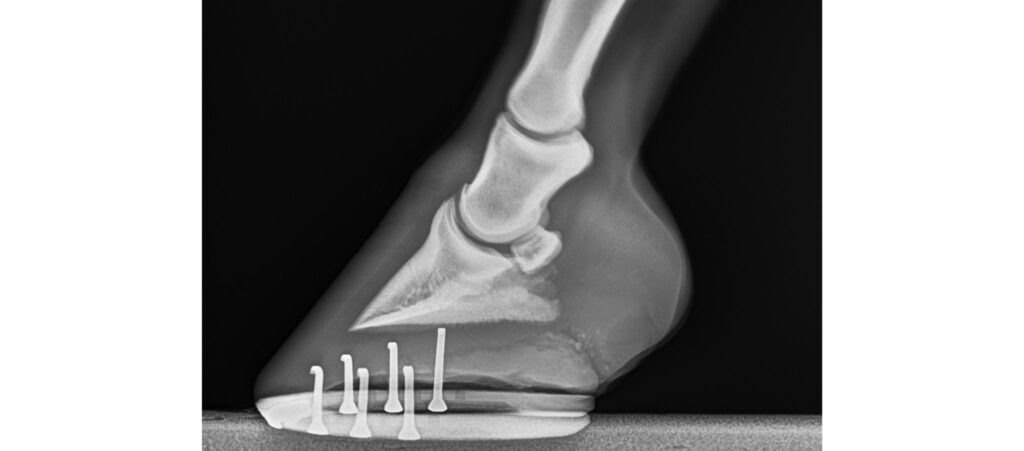
X-ray of the hoof
Hoof Angles
The angle of a horse’s hooves plays a significant role in his overall health and soundness.
For example, a horse with long toes and low heels will experience greater pressure on the navicular bone and is likely to land toe first, thereby shortening his stride.
The ideal angle of the horse’s hoof should be between 50-55 degrees.
This matches the angle of the dorsal surface of the pastern, creating a straight line from the pastern, through the hoof and to the ground.
Hoof Care
Caring for a barefoot hoof is much the same as caring for a shod one, but often a lot easier.
Barefoot hooves don’t collect mud and debris to the extent that shod ones do, but they still need to be picked out regularly to prevent potential injury and reduce the risk of thrush and other common hoof issues.
Farrier 101
Just because you’ve removed your horse’s shoes doesn’t mean you can forget about hoof care. Barefoot hooves need trimming just as frequently as shod ones and require just as much attention to detail.
Hoof Trimming
Finding a reputable and knowledgeable barefoot trimmer can be challenging, especially as there are no mandatory qualifications for barefoot trimmers.
While it is possible to learn how to trim a horse’s hooves yourself, it takes time, practice, and a fair amount of physical strength to do it correctly, so if you’re just starting on your barefoot journey, you’re better off getting a professional to do the job for you.
A barefoot horse’s hooves generally need trimming every four to six weeks, although this varies from horse to horse and is also depends on the environment.
I find my horse’s hooves grow faster in spring and summer and are also softer due to the higher rainfall. A farrier or barefoot trimmer will focus on several aspects of the hoof, including angle, break-over, flares, and overall hoof shape.
As your horse adapts to being barefoot, his hooves will expand and change shape, requiring a slightly different approach to each trim.
Horse Shoes
Shoes are beneficial in that they protect the horse’s hooves, especially on hard surfaces like gravel and roads.
As a result, when you first remove a horse’s shoes, you’re likely to see some sensitivity. This is because the horse’s soles have been elevated and protected for so long that they’re unaccustomed to making contact with the ground and need time to thicken and strengthen.
Hoof boots can help your horse transition from shod to barefoot more comfortably, and may prove necessary if you want to continue working him during this period.
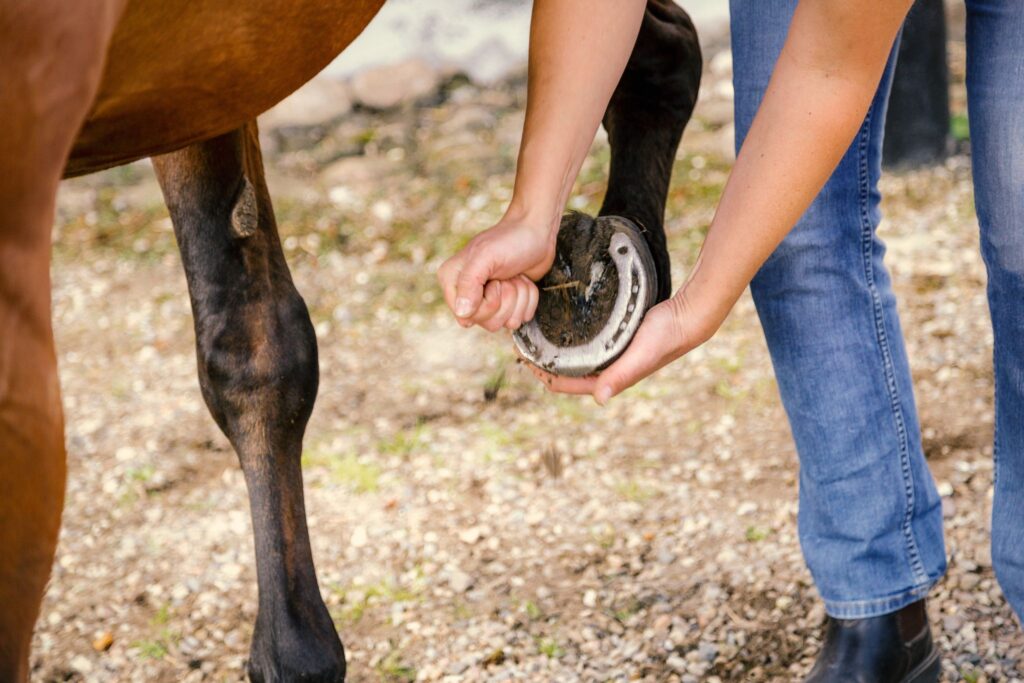
Source: Canva
Nutritional Supplements for Hooves
Nutrition plays a big part in hoof quality and health. Barefoot horses need a diet that’s high in fiber but low in sugar and starch, as both of these cause inflammation and hoof sensitivity.
You can give your barefoot horse extra support by supplementing his diet with biotin. This naturally occurring B vitamin is necessary for the production of keratin—the key structural protein responsible for the hoof’s strength and durability.
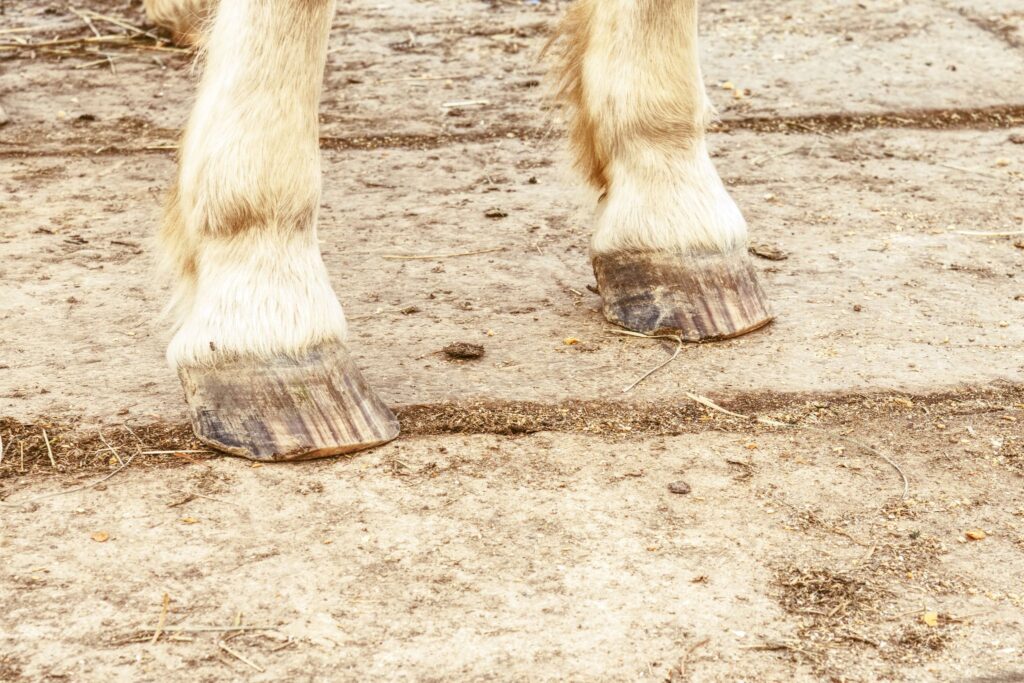
Source: Canva
Topical Treatments for Hooves
The one thing barefoot hooves can likely do without is hoof dressings and certain topical treatments. For the most part, hoof conditioners and dressings might not live up to their claims, as the hoof’s natural moisture barrier prevents topical applications from being absorbed.
Not only that, but studies also show that products claiming to improve flexibility and strengthen hooves have little, if any, impact.
But hoof dressing does have a place and time. Using hoof polish and hoof black can be damaging to the hoof, as it contains acetone which can be drying. Hoof dressing can make a nice alternative in the show pen.
We’re still on the fence about Keratex, a hoof hardening product. While some of us at Horse Rookie have used it and believe it to work, we couldn’t find any scientific studies to reinforce our observations on a more credible scale.
Topical products to treat conditions like thrush are effective.
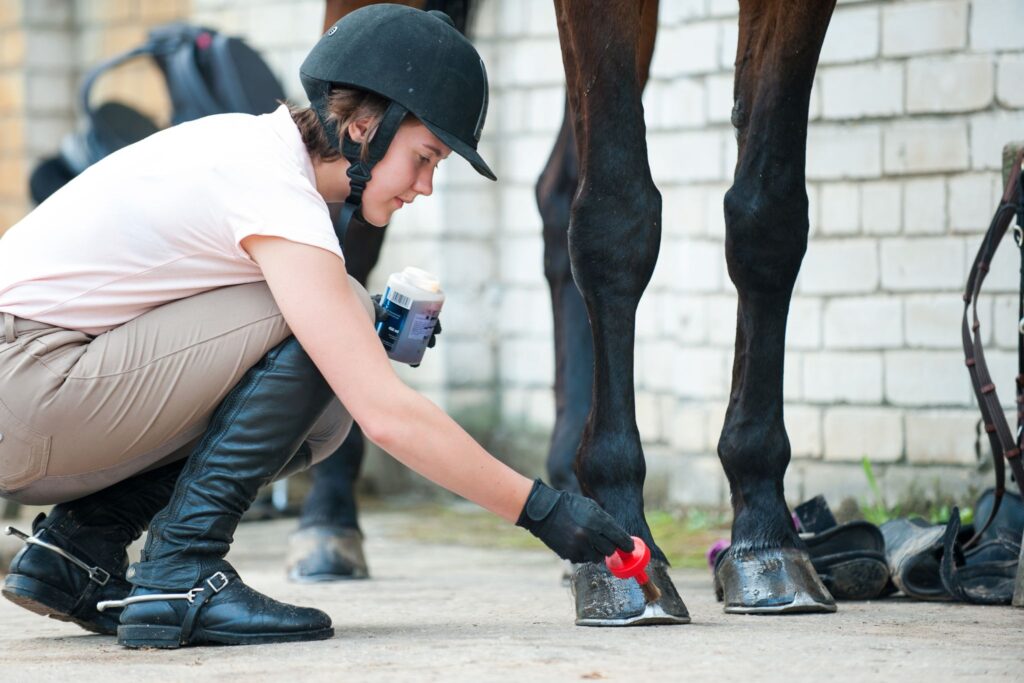
Source: Canva
Alternatives to Horse Shoes (boots for horses!)
Hoof boots can be a useful tool for helping a shod horse transition to barefoot, and can also be used to provide extra protection on hard ground.
If your horse lives on a grassy pasture, you’ll probably find he’s sensitive working on asphalt. Hoof boots can make your horse more comfortable on harder surfaces without inhibiting the natural mechanisms of the hoof in the way that metal shoes do.
Hoof boots aren’t nailed onto the hooves like shoes are, so can be removed after a training session, allowing your horse to enjoy his pasture time barefoot.
Cavallo Simple Hoof Boot
$194.52
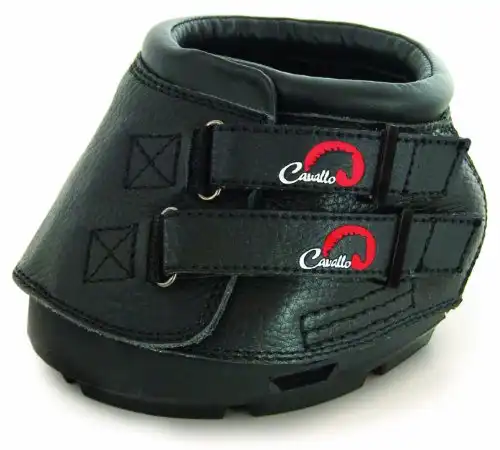
Click to see it at Amazon
02/29/2024 05:22 am GMT
The Benefits of Going Barefoot
While not all horses can be comfortable barefoot, many will benefit in the following ways:
- Better blood flow and circulation throughout the lower limbs
- More traction on a wide range of surfaces
- More expansion and compaction through the hoof provide more shock absorbency
- Stronger, healthier hooves
- A better way of going
How to Transition Your Horse To Going Barefoot
If you’re thinking of going barefoot, speak to your farrier and get their advice on how well your horse will cope without shoes and how best to support him through the transition period.
Bear in mind that transitioning your horse to being barefoot takes time and requires a holistic approach to his management.
If you focus only on your horse’s feet, your barefoot experiment will fail. You need to look at the whole horse when making the transition, making sure he’s getting the nutrition and exercise he needs.
You may need to reduce his sugar and starch intake or boost the roughage in his diet. You might need a supplement to offset any nutritional deficiencies that might restrict hoof strength and growth.

Source: Canva
As your horse adjusts to life without shoes, he needs to move around to increase circulation, promote hoof growth, and flush out toxins. In the early days, that means giving him plenty of turn-out time, but further down the line, it can include ridden work and even trail rides.
Keep an eye on your horse as you start riding him again and use hoof boots to protect his feet on harder surfaces. Remember, asphalt is very abrasive and could wear the hoof walls down too quickly, causing sensitivity and discomfort.
Frequently Asked Questions
Q: How long does it take for a horse to adjust to going barefoot?
Some horses transition in a matter of days, while others take months. It really depends on the condition of your horse’s hooves at the beginning of the process.
Q: Is it OK for a horse to be barefoot?
In the wild, horses are naturally barefoot, so it’s actually ideal. Barefoot horses have better circulation, traction, and shock absorbency than shod horses.
Q: How do you take care of a barefoot horse?
You care for a barefoot horse in much the same way as you would a shod one. They need a balanced diet, plenty of exercise, regular trimming, and routine hoof maintenance.
Q: How often should a barefoot horse be trimmed?
Most barefoot horses need trimming every four to six weeks, but some horses, especially those covering long distances, may only need a tidy-up every six months.
Q: Can all horses go barefoot?
Horses with strong hooves and good conformation benefit from being barefoot, while others may experience too much discomfort due to weak hooves or poor conformation to make it a viable option.
Parting Thoughts
Many people think that going barefoot means saving money and reducing grooming time, but that’s not the case. Barefoot horses need just as much care and attention as shod ones.
The real benefits of going barefoot are those the horse experiences—improved circulation, better traction and shock absorbency, and stronger, healthier hooves.
So, if going barefoot is an option for you and your horse—give it a whirl. You can always revert to shoes again if it doesn’t work out, but if it does, you’ll have a happy, healthier, and potentially sounder horse than you did before!
P.S. Enjoy this article? Trot on over to:
- Horse Hoof Terminology
- Hoof Talk: Tackling Seedy Toe, Thrush, Mud Fever, and More
- Rookie Real Life: A Pre Purchase Exam Case Study
- Fungus Free: Easy Homemade Recipes for Horse Thrush
- Get a Leg Up on Equine Limb Terminology
- Horse care 101: Turnout blankets vs. stable blankets
- Horse Riding Equipment List: What You Need & What You Don’t
Sources/References
Hoof Dressings: Helpful, Harmful, or Humbug? – Kentucky Equine Research
Horse Grooming Controversies
The post Barefoot Horses 101: Why You *May* Want to Go Barefoot appeared first on Horse Rookie.
Continue reading...
